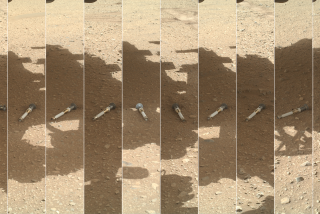Is Mars One ready to colonize the Red Planet? MIT engineers say no
A team of engineers at MIT that studies the technology needed for humans to live on other planets has determined that the Mars One plan to send four people to colonize the Red Planet by 2025 is not possible.
“The claim they make is that no new technology is required for their mission,” said Sydney Do, a doctoral candidate in aeronautics and astronautics at MIT and the lead author of the study. “Our numbers show that is not feasible.”
Mars One is a nonprofit organization based in the Netherlands that has boldly promised the world to send four people on a one-way trip to Mars by 2024, with an additional four people arriving every two years.
To finance the mission, the Mars One team has proposed a reality TV show in which 40 aspiring astronauts from around the world would compete to be the first people to settle on Mars.
The MIT team was already at work on building what they call a “settlement-analysis tool” (it’s a computer model) that would help them understand what was needed for humanity to live on another planet. After chatting about the Mars One project in their office one day, they decided to use their tool to see whether the Mars One plan had legs.
Their results are published in a 35-page report on the MIT website.
“It was a really good intellectual exercise for us,” Do said. “And it tested some of the our modeling capabilities that we’ve been trying to develop.”
To test the feasibility of Mars One’s plan to have colonizers grow all their food, the team built a simulated Martian habitat, put in data on how crops grow in space and then put in ideal growth conditions. Even with those ideal conditions, the Mars One would need an area four times larger than the one it had planned, they said.
They also found that the plan to have people living in the same environment as their crops was flawed. The crops would release too much oxygen, creating a fire hazard.
Koki Ho, another author on the paper and also a doctoral candidate at MIT, was in charge of studying transportation logistics. Mars One was hoping to launch the components for the settlement using six Falcon Heavy rockets. Ho figured out how you would pack these materials and determined it would take at least 11 rockets instead.
Andrew Owens, another member of the MIT team, looked at how many spare parts would need to be brought to the planet to keep the colony functioning. He determined that over time, replacing failed parts would get very costly and would take up an increasing amount of space in spacecraft that were also supposed to transport people.
In the end, they determined that it would be cheaper to send people to Mars on a round trip, rather than keep them there for years.
Before you start accusing the MIT engineers of being wet blankets, consider that these guys go to work every day and try to figure out how to make Mars colonization possible.
“We look forward to the day when humanity becomes an interplanetary species,” they write in an open letter on their group’s website. “We have great respect for the enthusiasm for space exploration that the Mars One program has generated and our goal is not to detract from this, but rather to drive it forward - towards enabling affordable, sustainable Mars colonization.”
Owens put it this way in an interview with The Times: “It’s not that Mars colonization is infeasible; it is just that technology development will be required to make it feasible.”
We’ll get there one day! Follow me @DeborahNetburn and “like” Los Angeles Times Science & Health on Facebook for more like this.







